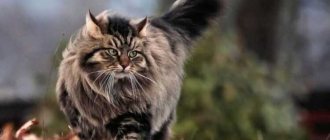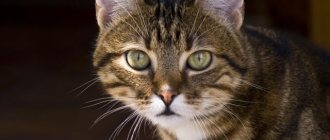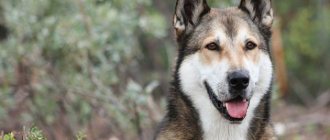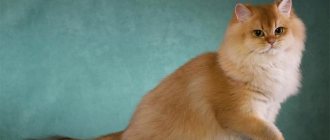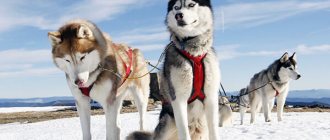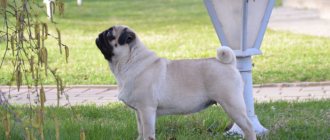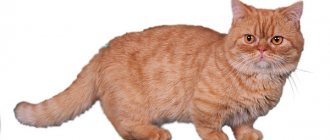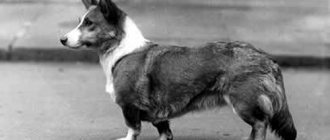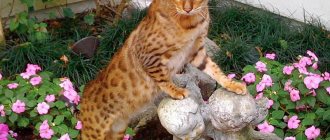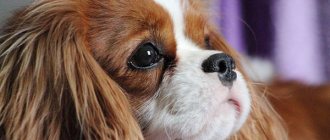In terms of popularity and success, the Siberian cat occupies almost a leading position among other breeds.
Representatives of the species are often credited with Russian roots, although in fact their ancestors were exclusively Asian cats.
And yet, even their foreign origin did not prevent them from winning the respect and title of real Russian heroes, whose goal is to protect housing by any means, to help its inhabitants in everything and to expand their habitat right up to the most extreme borders of not only our state, but to climb beyond its borders.
Breeders, in turn, repeatedly ask questions. For example, is it possible to pay attention to this fluffy beauty if there are children in the house? What are representatives of the Siberian cat breed like? How to properly care for and feed your pet for complete happiness?
It's time to reveal all the ins and outs and dispel existing myths about these charming creatures, leaving room for the truth.
Origin story
Despite its name, the grandmothers of the Siberian cat are considered to be people from Asia. Traveling with traders, Bukhara cats reached Siberia and, together with merchants, began to develop vast territories.
Local residents willingly bought animals for their dexterity and dexterity in fighting rodents. Gradually, Bukhara cats became close to representatives of local wild breeds, and their kittens acquired fluffy and warm skin and excellent hunting skills.
It is believed that the first representatives of this breed appeared in the east of the Urals and gradually spread throughout the cold region. The first mention of these animals was recorded in written sources of the 16th century.
In any photo, a Siberian cat shows all the charm of the fluffy breed.
Choosing a pet
A gray kitten can be separated from its mother at the age of 3 months. The baby should already learn how to use a tray, lap up food from a saucer, and also have the skills to communicate with other animals. According to owners' reviews, the animal's character changes slightly. That is why you need to carefully watch how the cat behaves in the nursery. If he is happy and active, you are in luck: he will be the best pet. You should avoid buying a timid and lethargic kitten. The fact is that infantile fear is very often the cause of unsociability and aggression in older age.
Character of the Siberian cat
Smart and quick-witted representatives of this breed, like true Siberians, are friendly and sociable. Although they can show their character on the other side - pride and independence also correspond to the description of this breed.
For recommendations on caring for cats at home, see the portal about animals https://zhivotnyeplanety.ru/.
Cats become very attached to people, although they do not like strangers, especially if they pick the cat up without permission. And they won’t allow their owners to squeeze them too much.
They treat children well, but will not allow them to hurt themselves.
Siberians are not a picky breed at all. They will play with whatever their owners offer them or get a toy on their own. This could be an ordinary candy wrapper, a piece of paper or rope.
A well-developed hunting instinct allows them to protect homes from rodents. There are known cases when such hunters, left without prey, caught ferrets and rabbits.
Siberian cats have well-developed jumping ability, so if the owners do not see the cat on the floor, they should inspect all the cabinets - the hunter can monitor the situation from above.
The Siberian breed can be used as watchdogs - they will selflessly defend their territory and are wary of strangers.
They are not afraid of dogs and can start a fight with them if they think that they have violated territorial boundaries. They are also not afraid of sharp sounds.
Siberians are considered calm and balanced animals, although the Siberian cat kitten loves to play and be naughty. Some cats retain their lively character even into adulthood.
The roots of wild cats will not allow her to adapt to a person; she will still remain in her opinion and will not follow people, asking for attention and affection.
But they will not leave the owner if he is sick or upset. To become a real owner for such a cat, you must respect the requirements and dignity of the animal.- Animal cremation.
What are the benefits of grooming animals?
- Ultrasound of animals. Why is it made?
Survival in the harsh conditions of Siberia has developed prudence and intelligence in these cats. She will think first and then act.
The Siberian breed is excellent for private homes, where it is given opportunities for hunting and walking. A cat living in the city should be taken for walks regularly.
A pet of this breed must have its own place - a house or a bed - where no one will touch it. A multi-tiered cat house is well suited for this purpose, in which the animal can play and sleep.It is advisable to wear a harness so that the animal does not run away, driven by hunting instincts.
Catering
If you feed an animal based only on its tastes - for example, only meat or fish - sooner or later its metabolism will be disrupted, problems with its kidneys, fur and teeth will arise. Therefore, remember the following rules:
- A healthy Siberian cat is fed 2 times a day: morning and evening. Serving size: 30-60 g per kg weight). A pregnant, lactating individual, with chronic diseases or an old one can be fed 3 times, or the portions can be increased.
- In addition to food and water, they grow grass (you can buy it at a pet store). The animal will come to her when he wants. The weed helps cleanse the stomach and is also an additional source of folic acid, vitamins and fiber.
Natural products
What is included in the diet if you choose natural food.
- Meat - all varieties: streaky beef, lean lamb, rabbit, turkey, veal, lamb. The meat is pre-frozen, and before feeding, it is doused with boiling water and cut (or minced). It is better to boil chicken. Bones, tripe and skin are not given; lard, duck and goose meat, and pork are also prohibited.
- Offal: heart (boiled), liver (stewed or boiled), kidneys and lungs (boiled), udder (a little fatty, so you can give it occasionally).
- Fish - sea varieties. These are flounder, tuna, hake, trout, cod, salmon. Raw fish causes intestinal upset and negatively affects the appearance, so the product is boiled or stewed. Fatty varieties - herring, mackerel, sprat - can be given rarely. Canned fish from pollock and cod - little by little and as a delicacy.
- Chicken eggs - boiled and only the yolk. Raw eggs are poorly digested by Siberians. Quails can be given whole.
- Dairy products: cottage cheese (with whey or egg yolk), fermented baked milk, sour cream, Varenets, natural yogurt, unleavened cheese. Products with dyes and pieces of fruit are prohibited. Whole cow's milk is given only if the cat does not have a negative reaction to it: diarrhea or vomiting.
- Vegetables: beets, carrots, pumpkin, green peas, cabbage (kohlrabi, cauliflower and white cabbage), some gourmets like to nibble on cucumbers and tomatoes. Vegetables are stewed and added to the porridge, rubbed with vegetable or olive oil.
- Cereals: oatmeal, rice, buckwheat, barley, pearl barley. Porridge is cooked in water or diluted milk, without sugar or salt.
- Fruits are not a necessity, but are allowed as a treat. Treat your pet to a piece of melon or apple or strawberry.
- Greens: parsley, dill, green salad, fresh nettle scalded with boiling water.
- Rye bread – a small piece once a week is enough. Bone meal is given if the cat refuses dairy products.
You cannot give:
- Dog food;
- Human vitamins;
- Sweet, smoked, salty, baked goods, flour;
- Tea, coffee, sparkling and mineral water, coffee, juices, alcohol;
- Eggplants, grapes, citrus fruits, legumes.
A piece of sugar-free cookie can be given as a reward, for example, during training.
Expert opinion
Dusheba Vera Ivanovna
In 2010, she graduated from the Moscow State Academy of Veterinary Medicine named after K.I. Scriabin with honors, specializing in veterinary medicine. I regularly attend veterinary conferences, congresses, and webinars.
Choose bowls for water and food that are shallow and stable. If you feed your cat natural food, you should wash the dishes after each meal. After dry food - once a week. Water should be freely available, clean and at a comfortable warm temperature. You can't pour from the tap! Give your cat bottled water or use tap water at home. If there is no fresh water in the bowl, the “Siberian” will climb into the toilet or try to open the tap on its own.
Recommended food
Industrial prepared food is divided into 4 groups.
Economy class food is the cheapest, but also the most stupid. Made from food waste, they contain a small amount of vitamins. TerraCat, Friskies, Perfect Fit.
Premium food is somewhat of a higher quality, but the percentage of meat is low, and the vitamins and minerals are not enough for the animal to fully exist. Mnyams, Night Hunter, Native food.
Super-premium and holistic food is made from high-quality products and contains the necessary minerals and vitamins for the growth and development of the animal. But such food is not cheap. Examples: super-premium - Brit Care, Leonardo, Vet Life; holistic - Jaguar, Nutram, Naturea.
Below are recommended super-premium foods. Links with the names of the food are clickable, on them you can, within our website, get acquainted with the descriptions of the food and read reviews from the owners of the Siberian cat breed.
| Holistic | Super premium | Premium |
| Acana | Brooksfield | Royal Canin |
Training
The Siberian cat is quite smart. With some persistence, you can teach her to fetch things and follow a few simple commands.
When training, you should not shout at the animal; this can ruin the entire learning process and discourage the desire to learn commands. It is better to use affection and encouragement.
- Where can I take veterinary courses and what are they for?
- Akita Inu. What kind of breed is this and what are its characteristics?
Siamese cat - description of the breed, character and features of caring for Siamese cats (105 photos and videos)
Psychology
The Siberian cat has a difficult character, since these animals are full of their own dignity, and it is rarely possible to subjugate them to your will.
Some innate stubbornness cannot be broken by any punishment or training, so there is no point in being overzealous with training.
But a little strictness in raising a cat of this type will not hurt.
The distinctive character traits of a Siberian include:
- Devotion. The Siberian cat, like the Oriental , always chooses one leader “from the pack”, i.e. She will be faithful to the owner, but will treat the rest of the family members condescendingly, and maybe even with a hint of superiority.
- Calm. The Siberian cat will not jump, frolic or circle around the table; these animals are distinguished by poise and elegance, although sometimes the Siberian can take liberties.
The Siberian cat always chooses one leader “from the pack”, i.e. she will be faithful to the owner, but will treat the rest of the family members condescendingly, and maybe even with a hint of superiority
- Following habits. The only hobby for a Siberian will be his favorite toys. With their help, you can lure a cat to the right place, and game items left unattended can cause unexpected fun for the owners.
- Caution. In a room with strangers, the Siberian cat will behave carefully and, like the Scottish Straight , is unlikely to be handled, but it usually does not show aggression, trying to go to an inconspicuous place for a while.
One of the ways to determine the character of a Siberian cat is a photo or video with its participation; the pet’s external behavior reveals its temperament.
There are cats that spend almost all their time in a calm state - sleeping or simply resting on the bed.
And other representatives of the breed explore everything around, but do it gracefully and carefully, without noise or running around.
The Siberian cat has a complex character and brindle color. Since these animals are full of their own dignity, it is rarely possible to subjugate them to your will.
Description of the Siberian cat breed
The animals have a strong, muscular body and have magnificent thick fur that protects its owner during frosts.
With the onset of cold weather, the fur coat becomes even warmer, and winter pants and a collar appear. Due to its special properties, the animal’s fur does not get wet very well.The colors of the Siberian cat can be very diverse. White and black, silver and blue, brindle and tortoiseshell, two- or three-color colors are acceptable here.
Standards
The appearance of the Siberian cat is impressive: its body is powerful, large, covered with thick and long hair. Females weigh 4-5 kg, the weight of an adult cat is much larger - 7-8 kg, and sometimes reaches up to 12! These are real long-livers - sometimes they live up to 20 years.
| Standard | Description |
| Head | Trapezoidal, with smooth lines. There is no clearly defined “stop”. The chin is clearly defined, as are the cheekbones, and the cheeks are round and full. |
| Ears | Wide at the bottom, triangular, with rounded tips. They are slightly inclined forward, pubescent both outside and inside. |
| Eyes | Oval, very expressive. Small, but open. Placed slightly obliquely, widely. Iris color: yellow or green (all shades). |
| Torso | Massive, with a wide back and a strong rear. The chest is voluminous, the neck is muscular and short. The paws are thick, of medium length, with well-developed muscles. The paws are round and wide, flattened. The fur grows in tufts between the toes. |
| Tail | Long and shaggy, tapering towards the tip. |
| Wool | The coat is very dense. The undercoat is very soft and delicate to the touch (due to the fact that the texture of the hairs is thin). The top layer of wool is stiffer, grows evenly, and in the area of the sides and tail seems to “fall” down. Siberian wool repels moisture well. By winter, the “fur coat” becomes thicker and shinier, especially in the area of the “collar” and “panties” on the hind legs. |
Significant disadvantages of the breed:
- “Bare” fingers;
- Coat growing in tufts and dull, lack of undercoat;
- Tail with bald spots, short or too long;
- Eyes that are too big or small;
- Ears too small or large;
- Flat cheeks, elongated muzzle, long thin neck, poorly developed bones.
Photo of a Siberian cat
Read here Laperm: description of the breed, keeping a purebred cat and features of its choice (130 photos)
Help the site, share with friends 
Health
Characteristic diseases
The Siberian cat is characterized by good health, this breed is practically not susceptible to diseases, but illiterate care or congenital defects can negatively affect the condition of an adult pet.
Don't be surprised if your Siberian cat periodically goes out on business. This is fine. She'll take a walk and come home
The most common congenital disease is hypertrophic cardiomyopathy - genetic changes in the walls of the ventricles, but this is the exception rather than the rule.
Vaccinations
To completely eliminate health problems, cats need to be vaccinated regularly.
It is also necessary to give medications against helminths and monitor the condition of the ears and teeth.
Colors
More than two hundred different colors of the Siberian are known. Some of them are not recognized by all felinological systems, others, due to their exclusivity, allowed subspecies to be distinguished into separate breeds. The most common types of colors:
Solid or solid
The entire coat is dyed the same color. There are two main types - solid black (black) and solid red (red or bright red). Solid blue is often found - it is a type of black, solid cream is a subtype of red.
Rich tones of black and red and lightened tones of blue and cream are appreciated. In all these colors, spots of other tones and colors are not allowed, the coat should not have a brown, faded tint - they need protection from the sun.
The eyes, paw pads and nose usually correspond to the color of the coat, but there are no strict restrictions on this trait in the breed standard.
Tortoiseshell or tabby cake
When two solid colors, red and black, combine, a red and black torti is formed. Blue and cream solids produce a blue-cream tortoiseshell color.
Spots of two colors are evenly distributed over the animal’s body, merging into a common melange background. Such colors are more typical for females; males are rare, but they do occur. The presence of a “tongue of flame” on the forehead is considered a plus. This coloring is often called tricolor.
Advantages and disadvantages
Like any other cat breed, the Siberian cat has its own characteristic features.
Advantages of the breed:
- playful, affectionate, gentle;
- gets along well with children;
- unpretentious;
- quickly gets accustomed to the toilet and scratching post.
Disadvantages of the breed:
- may be willful;
- restless;
- suffers from mood swings and does not always respond in kind to the owner’s affection;
- Requires daily brushing during shedding.
There is a version that the Siberian breed is hypoallergenic. However, there are no completely hypoallergenic cats. People with allergies, to make sure whether a Siberian will cause a reaction, can spend several hours in his company and finally decide whether to get this breed.
